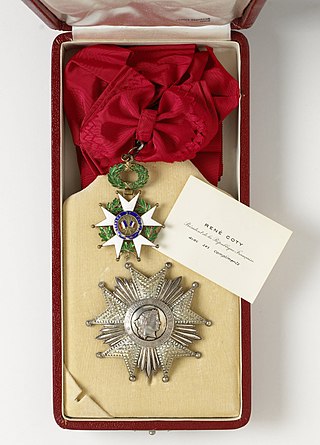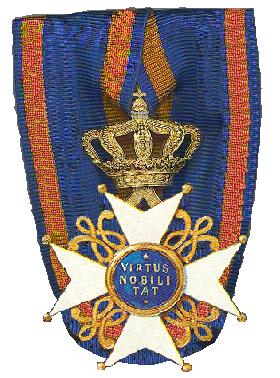
The National Order of the Legion of Honour, formerly the Royal Order of the Legion of Honour, is the highest French order of merit, both military and civil. Established in 1802 by Napoleon Bonaparte, it has been retained by all later French governments and regimes.

The Most Honourable Order of the Bath is a British order of chivalry founded by King George I on 18 May 1725. The name derives from the elaborate medieval ceremony for appointing a knight, of which bathing was an element. Knights so created were known as "Knights of the Bath". George I constituted the Knights of the Bath a regular "Military Order". He did not revive the Order of the Bath, which had not previously existed as an Order, in the sense of a body of knights governed by a set of statutes and whose numbers were replenished when vacancies occurred.

The Order of Merit of the Federal Republic of Germany is the only federal decoration of Germany. It is awarded for special achievements in political, economic, cultural, intellectual or honorary fields. It was created by the first President of the Federal Republic of Germany, Theodor Heuss, on 7 September 1951. Colloquially, the decorations of the different classes of the Order are also known as the Federal Cross of Merit.

The Order of the Iron Crown was an order of merit that was established on 5 June 1805 in the Kingdom of Italy by Napoleon Bonaparte under his title of Napoleon I, King of Italy.

The Order of Orange-Nassau is a civil and military Dutch order of chivalry founded on 4 April 1892 by the queen regent, Emma of the Netherlands.

The Order of the Netherlands Lion, also known as the Order of the Lion of the Netherlands is a Dutch order of chivalry founded by King William I of the Netherlands on 29 September 1815.

The Order of Civil and Military Merit of Adolph of Nassau is an order of merit of the Grand Duchy of Luxembourg for meritorious service to the Grand Duke, the Grand-Ducal House and Luxembourg. It was founded in 1858 as a chivalric order of the Duchy of Nassau by Adolphe of Nassau in honor of his namesake and ancestor, Adolf, Count of Nassau, the only member of the House of Nassau to have been Roman King of Germany. After the Duchy of Nassau was annexed by Prussia in 1866 and Adolphe became Grand Duke of Luxembourg in 1890, he revived the order as an order of merit.

The Royal Guelphic Order, sometimes referred to as the Hanoverian Guelphic Order, is a Hanoverian order of chivalry instituted on 28 April 1815 by the Prince Regent. It takes its name from the House of Guelph, of which the Hanoverians were a branch. Since Hanover and the United Kingdom shared a monarch until 1837, the order was frequently bestowed upon British subjects.

William, Prince of Hohenzollern was the eldest son of Leopold, Prince of Hohenzollern and Infanta Antónia of Portugal.

The House and Merit Order of Duke Peter Frederick Louis or proper German Oldenburg House and Merit Order of Duke Peter Frederick Louis was a civil and military order of the Grand Duchy of Oldenburg, a member state of the German Empire. The order was founded by Grand Duke Augustus of Oldenburg on 27 November 1838, to honor his father, Peter Frederick Louis of Oldenburg. It became obsolete in 1918 after the abdication of the last grand duke.

The orders, decorations and medals of Finland form a system through which the Finnish government shows its respect to persons who have distinguished themselves on some walk of life. The legal basis of the system is the Act on the displays of public recognition (1215/1999) which grants the president the authority to issue decrees on orders, medals and titles.

The Order of Isabella the Catholic is a Spanish civil order and honor granted to persons and institutions in recognition of extraordinary services to the homeland or the promotion of international relations and cooperation with other nations. The Order is open to both Spaniards and foreigners.

Helmuth Ludwig Wilhelm Freiherr von Maltzahn was a German finance minister and a representative in the Reichstag.

August Wilhelm Heye was a German officer who rose to the rank of Generaloberst and became head of the Army Command within the Ministry of the Reichswehr in the Weimar Republic. One of his sons was admiral Hellmuth Heye.

The Albert Order was created on 31 December 1850 by King Frederick Augustus II of Saxony to commemorate Albert III, Duke of Saxony. It was to be awarded to anyone who had served the state well, for civil virtue, science and art.

The Order of the Reunion was an order of merit of the First French Empire, set up to be awarded to Frenchmen and foreigners to reward services in the civil service, magistracy and army, particularly those from areas newly annexed to France, such as the Kingdom of Holland. It was established in 1811 and abolished in 1815. There were similar orders in the other states annexed by France, such as the Palatinate, Papal States, Tuscany and Piedmont, including the Order of the Lion of Bavaria, the Order of the Golden Spur, the Order of St John Lateran, the Order of Saint Stephen, the Order of the Most Holy Annunciation and the Order of Saints Maurice and Lazarus.

The Military Order of Savoy was a military honorary order of the Kingdom of Sardinia first, and of the Kingdom of Italy later. Following the abolition of the Italian monarchy, the order became the Military Order of Italy.
This is a list of Orders, decorations, and medals of Austria-Hungary.
The following is a comprehensive list of orders, decorations, and medals bestowed by the Sovereign Military Order of Malta, both in the present-day and historically.

The House Order of Henry the Lion In German: Hausorden Heinrichs des Löwen, was the House Order of the Duchy of Brunswick. It was instituted by William VIII, Duke of Brunswick on 25 April 1834. The ribbon of the Order was red with yellow edges. It had five grades: Grand Cross, Grand Commander with Sash, Commander, Knight 1st Class, Knight 2nd Class, plus Medal of Merit for Science and Arts, the Cross of Merit and the Medal of Honour. The Order was named in honour of Henry the Lion, who remains a popular figure to this day.



















